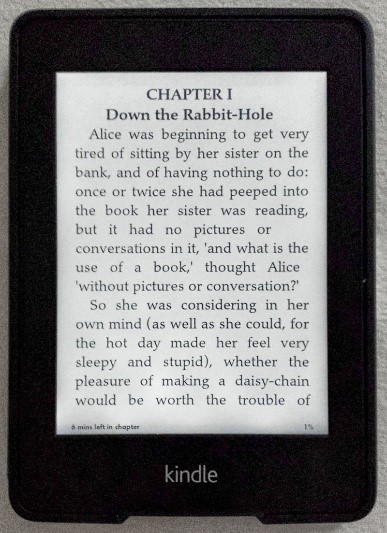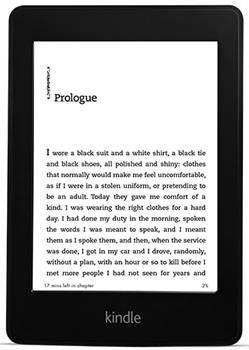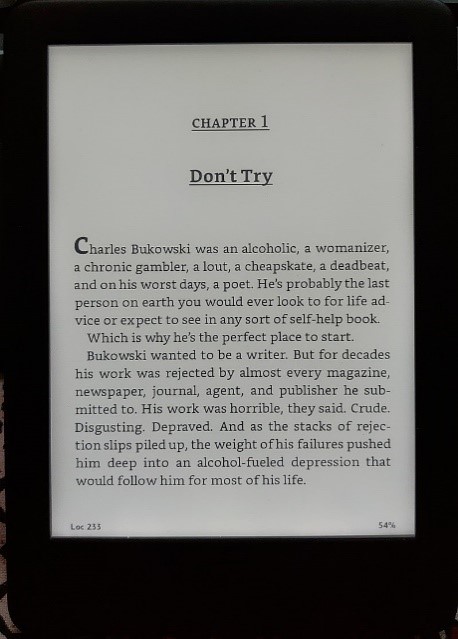On September 21, 2021, Amazon announced Kindle Paperwhite (fifth generation) as the first of its eleventh generation Kindle e-reader in the series. The article in this page covers first generation to the fifth generation of Kindle Paperwhite. Compare specifications and prices to buy Amazon Kindle Paperwhite that suits you.
Kindle Paperwhite (First Generation)
The first-generation Kindle Paperwhite was announced on September 6, 2012, and released on October 1.

It has a 6 in, 212 PPI E Ink Pearl display (758×1024 resolution) with four built-in LEDs to illuminate the screen.
It was available in Wi-Fi ($120 ad-supported, $140 no ads) and Wi-Fi + 3G ($180 ad-supported, $200 no ads) models, with the ad-supported options only intended to be available in the United States.
The light is one of the main features of the Paperwhite and it has a manually adjusted light level. The 3G access restrictions are the same as the Kindle Touch, and usage of the 3G data is limited to 50 MB per month and only on Amazon and Wikipedia’s websites; additional data may be bought.
Battery life is advertised as up to eight weeks of reading with half an hour per day with wireless off and constant light use; this usage equals 28 hours.
The official leather cover for the Paperwhite uses a hall effect sensor to detect when the cover is closed or opened and turn the screen off or on respectively. This was the first Kindle model to track reading speed to estimate when the reader will finish a chapter or book; this feature was later included with updates to the other models of Kindle and Kindle Fire.
The Kindle Paperwhite lacks physical buttons for page turning and does not perform auto-hyphenation. Except for the lock screen/power button at its bottom, it relies solely on the touchscreen interface.
In November 2012, Amazon released the 5.3.0 update that allowed users to turn off recommended content on the home screen in Grid View (allowing two rows of user content) and included general bug fixes.
In March 2014, the Paperwhite 5.4.4 update was released that added Goodreads integration, Kindle FreeTime to restrict usage for children, Cloud Collections for organization and Page Flip for scanning content without losing your place, which closely matched the Paperwhite 2’s software features.
The Kindle Paperwhite was released in most major international markets in early 2013, with Japan’s version including 4 GB of storage, and in China on June 7, 2013; all non-Japan versions have 2 GB of storage (1.25 GB usable).
Engadget praised the Paperwhite, giving it 92 of 100. The reviewer liked the front-lit display, high contrast, and useful software features, but did not like that it was less comfortable to hold than the Nook, the starting price includes ads, and it had no expandable storage.
Shortly after release, some users complained about the lighting implementation on the Kindle Paperwhite.
While not widespread, some users found the lighting inconsistent, causing the bottom edge to cast irregular shadows. Also, some users complained that the light cannot be turned off completely.
Paperwhite (Second Generation)
Amazon announced the second-generation Kindle Paperwhite, marketed as the “All-New Kindle Paperwhite” and colloquially referred to as the Paperwhite 2, on September 3, 2013; the Wi-Fi version was released in on September 30 ($120 ad-supported, $140 no ads), and the 3G/Wi-Fi version was released in the US on November 5, 2013 ($190 ad-supported, $210 no ads).

The Paperwhite 2 features a higher contrast E Ink Carta display technology, improved LED illumination, 25% faster processor (1 GHz) that allows for faster page turns, and better response to touch input compared to the original Paperwhite.
It has the same 6″ screen with 212 PPI, bezel and estimated 28-hour battery life as the original Paperwhite. The software features dictionary/Wikipedia/X-Ray look-up, Page Flip that allows the user to skip ahead or back in the text in a pop-up window and go back to the previous page, and Goodreads social integration.
The Paperwhite 2 uses a similar experimental web browser with the same 3G data use restrictions as previous Kindles; there are no use restrictions when using Wi-Fi.
The official Amazon leather cover for the Paperwhite 2 is the same item as was used for the original Paperwhite. The cover’s magnets turn the screen on and off when it is opened and closed.
Although released in 2013 with 2GB of storage, all versions of the Paperwhite 2 were sold with 4GB of storage by September 2014.
Engadget rated the Paperwhite 2 as 93 of 100, saying while it offers few new features, “an improved frontlight and some software tweaks have made an already great reading experience even better.”
Paperwhite (Third Generation)
The third-generation Kindle Paperwhite, marketed as the “All-New Kindle Paperwhite” and colloquially referred to as the Paperwhite 3 and Paperwhite 2015, was released on June 30, 2015, in the US.

It is available in Wi-Fi ($120 ad-supported, $140 no ads) and Wi-Fi + 3G ($190 ad-supported, $210 no ads) models.
It has a 6-inch, 1448×1072, 300 ppi E Ink Carta HD display, which is twice the pixels of the original Paperwhite and has the same touchscreen, four LEDs and size as the previous Paperwhite.
It has over 3 GB of user accessible storage. This device improved on the display of PDF files, with the possibility to select text and use some functionalities, such as translation on a PDF’s text.
Amazon claims it has 6 weeks of battery life if used for 30 minutes per day with wireless off and brightness set to 10, which is about 21 hours.
The Paperwhite 3 is the first e-reader to include the Bookerly font, a new font designed by Amazon, and includes updated formatting functions such as hyphenation and improved spacing.
The Bookerly font was added to most older models via a firmware update.
The official Amazon leather cover for the Paperwhite 3 is the same item as was used with the previous two Paperwhite devices.
In February 2016, the Paperwhite 2, Paperwhite 3, Kindle 7, and Voyage received the 5.7.2 update that included a new home screen layout, an OpenDyslexic font choice, improved book recommendations and a new quick actions menu.
On June 30, 2016, Amazon released a white version of the Paperwhite 3 worldwide; the only thing different about this version is the color of the shell.
In October 2016, Amazon released the Paperwhite 3 “Manga Model” in Japan that has a 33% increase in page-turning speed and includes 32GB of storage, which is space for up to 700 manga books.
The Manga model launched at 16,280 yen (~$156) for the ad-supported Wi-Fi version or 12,280 yen (~$118) for Prime members.
The Verge rated the Paperwhite 3 as 9.0 of 10, saying that “The Kindle Paperwhite is the best e-reader for most people by a wide margin” and liked the high-resolution screen but disliked that there was no adaptive backlight; this is featured on the Kindle Voyage.
Popzara called the 2015 Paperwhite “the best dedicated E Ink e-reader for the money.”
Paperwhite (Fourth Generation)
Amazon announced the fourth-generation Kindle Paperwhite on October 16, 2018 and released it on November 7, 2018; it is colloquially referred to as the Paperwhite 4 and Paperwhite 2018.

It is available in 8 GB Wi-Fi, 32 GB Wi-Fi and 32 GB Wi-Fi + 4G LTE models.
It features a 6-inch plastic-backed display of Amazon’s own design with 300 ppi and a flush screen featuring five LED lights.
It is waterproof with an IPX8 rating, allowing submersion in 2 meters of fresh water for up to one hour. It supports playback of Audible audio books only by pairing with external Bluetooth speakers or headphones.
The Verge rated the Paperwhite 4 as 8.5 of 10, praising its great display, water-resistance and battery life but criticizing its lack of physical buttons and no USB-C support.
Kindle Paperwhite (Fifth Generation)
Amazon announced the Kindle Paperwhite (fifth generation) on September 21, 2021, and it was released on October 27, 2021.
It features similar dimensions to its predecessor but has a larger 6.8-inch display set in thinner bezels, 17 LEDs in the front light that can adjust color temperature to warmer tones (first featured in Kindle Oasis 3), an updated processor, and longer battery life that Amazon claims lasts up to ten weeks on a single charge.
It is the first Kindle with a USB-C port. The Kindle Paperwhite 5 is also available in a higher cost Signature Edition that additionally supports Qi wireless charging, has 32 GB of storage, and includes a sensor that automatically adjusts the color temperature.
Amazon has stated that some Qi chargers are incompatible and recommends using an Amazon charging dock. The Verge gave the Kindle Paperwhite (fifth generation) 8.5 out of 10, praising the display and battery but did not like the lack of physical buttons and lack of support for e-books found outside of the Kindle Store.
